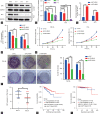Mannose inhibits the growth of prostate cancer through a mitochondrial mechanism
- PMID: 35142655
- PMCID: PMC9491030
- DOI: 10.4103/aja2021104
Mannose inhibits the growth of prostate cancer through a mitochondrial mechanism
Abstract
The limited treatment options for advanced prostate cancer (PCa) lead to the urgent need to discover new anticancer drugs. Mannose, an isomer of glucose, has been reported to have an anticancer effect on various tumors. However, the anticancer effect of mannose in PCa remains unclear. In this study, we demonstrated that mannose inhibits the proliferation and promotes the apoptosis of PCa cells in vitro, and mannose was observed to have an anticancer effect in mice without harming their health. Accumulation of intracellular mannose simultaneously decreased the mitochondrial membrane potential, increased mitochondrial and cellular reactive oxygen species (ROS) levels, and reduced adenosine triphosphate (ATP) production in PCa cells. Mannose treatment of PCa cells induced changes in mitochondrial morphology, caused dysregulated expression of the fission protein, such as fission, mitochondrial 1 (FIS1), and enhanced the expression of proapoptotic factors, such as BCL2-associated X (Bax) and BCL2-antagonist/killer 1 (Bak). Furthermore, lower expression of mannose phosphate isomerase (MPI), the key enzyme in mannose metabolism, indicated poorer prognosis in PCa patients, and downregulation of MPI expression in PCa cells enhanced the anticancer effect of mannose. This study reveals the anticancer effect of mannose in PCa and its clinical significance in PCa patients.
Keywords: mannose; mannose phosphate isomerase; metabolism; mitochondria; prostate cancer.
Conflict of interest statement
None
Figures





References
-
- Siegel RL, Miller KD, Fuchs HE, Jemal A. Cancer statistics, 2021. CA Cancer J Clin. 2021;71:7–33. - PubMed
-
- Cattaruzza L, Fregona D, Mongiat M, Ronconi L, Fassina A, et al. Antitumor activity of gold(III)-dithiocarbamato derivatives on prostate cancer cells and xenografts. Int J Cancer. 2011;128:206–15. - PubMed
-
- Gonzalez PS, O'Prey J, Cardaci S, Barthet VJ, Sakamaki JI, et al. Mannose impairs tumour growth and enhances chemotherapy. Nature. 2018;563:719–23. - PubMed
-
- Lu J, Dong W, He H, Han Z, Zhuo Y, et al. Autophagy induced by overexpression of DCTPP1 promotes tumor progression and predicts poor clinical outcome in prostate cancer. Int J Biol Macromol. 2018;118:599–609. - PubMed
MeSH terms
Substances
LinkOut - more resources
Full Text Sources
Medical
Research Materials

